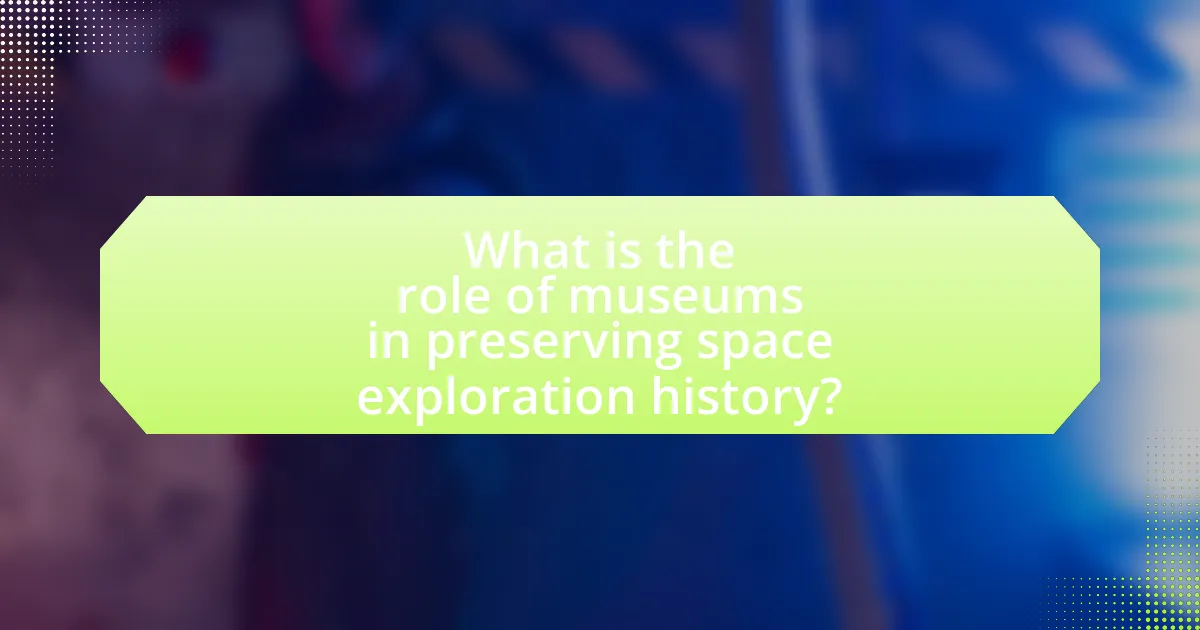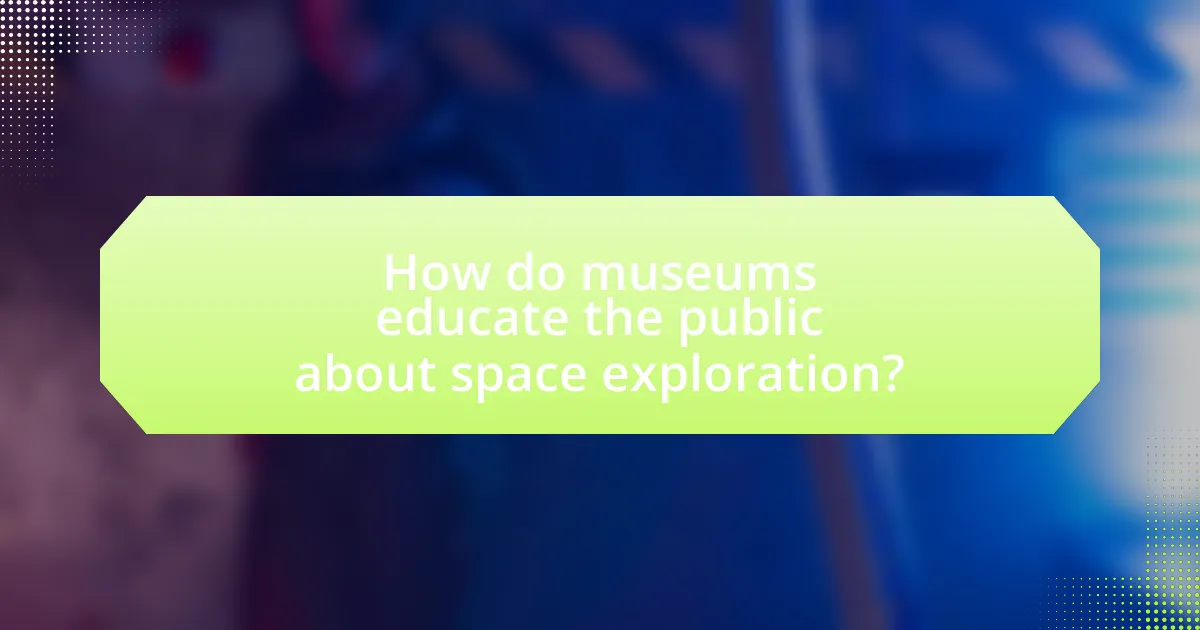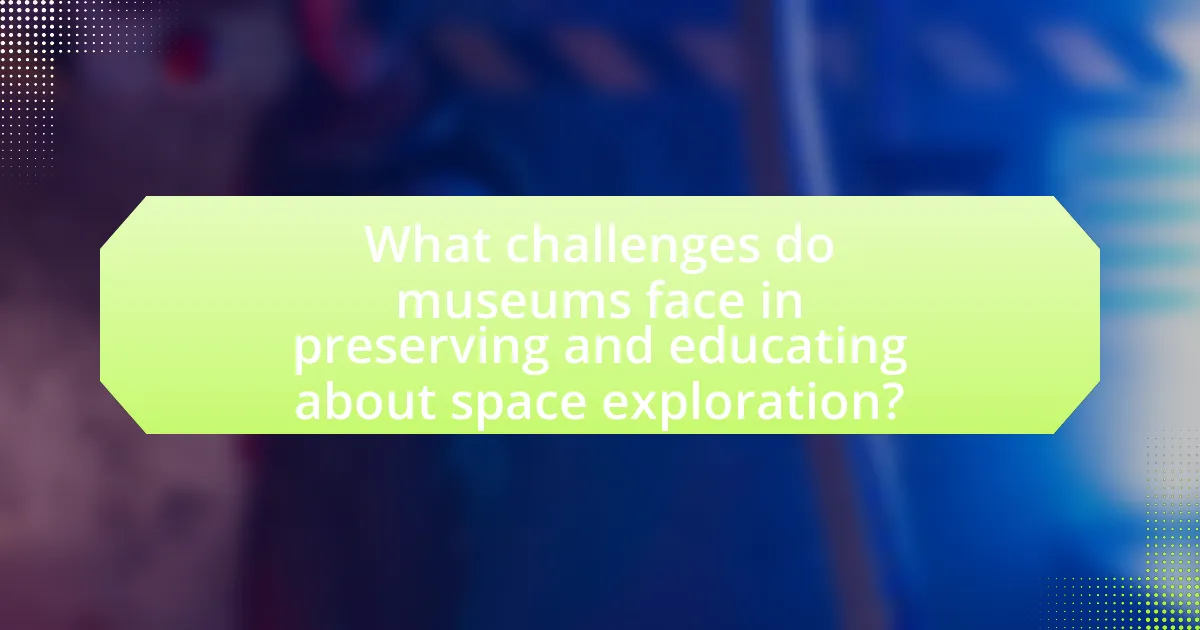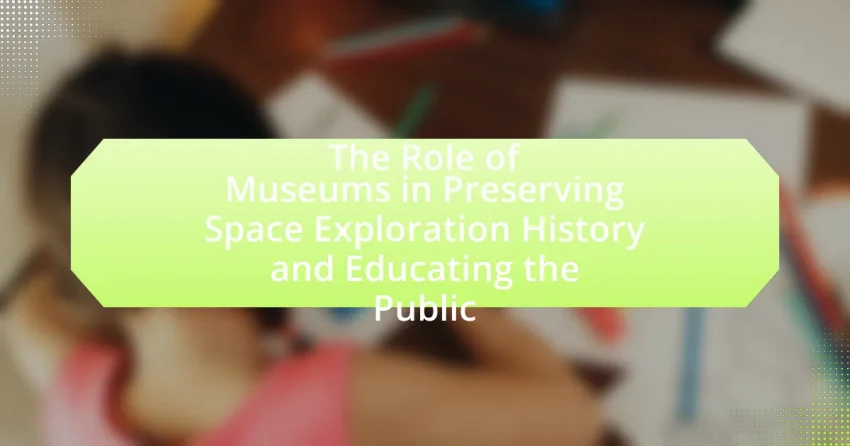Museums play a vital role in preserving the history of space exploration by curating and conserving significant artifacts, documents, and exhibits that highlight key achievements in the field. They engage in systematic processes to collect, authenticate, and display items such as spacecraft, space suits, and scientific instruments, ensuring these historical objects are maintained for future generations. Through educational programs and interactive exhibits, museums foster public understanding of space exploration’s impact on science and society, while also inspiring future innovation. The article explores the methods museums use to collect and curate artifacts, the importance of preserving space history, and the challenges they face in funding and technological advancements.

What is the role of museums in preserving space exploration history?
Museums play a crucial role in preserving space exploration history by curating artifacts, documents, and exhibits that chronicle significant achievements and milestones in the field. They collect and conserve items such as spacecraft, satellite models, and personal items from astronauts, ensuring that these historical objects are maintained for future generations. For instance, the Smithsonian National Air and Space Museum houses the Apollo 11 command module, which symbolizes human achievement in space travel. Additionally, museums provide educational programs and exhibitions that engage the public, fostering an understanding of space exploration’s impact on science and society. Through these efforts, museums not only safeguard history but also inspire future innovation in aerospace.
How do museums collect and curate artifacts related to space exploration?
Museums collect and curate artifacts related to space exploration through a systematic process involving acquisition, preservation, and exhibition. They acquire artifacts via donations from space agencies, private collectors, and individuals, often focusing on items that have historical significance, such as spacecraft, tools, and personal items from astronauts. For instance, the Smithsonian National Air and Space Museum has a collection that includes the Apollo 11 command module, which was donated by NASA.
Once acquired, museums preserve these artifacts using specialized techniques to ensure their longevity, including climate control and conservation methods tailored to the materials involved. Curators then research and interpret the artifacts to create informative displays that educate the public about space exploration’s history and impact. This process is exemplified by the Kennedy Space Center Visitor Complex, which features exhibits that detail the history of NASA’s missions and the technology used.
Overall, museums play a crucial role in preserving space exploration history by carefully collecting, preserving, and curating artifacts that tell the story of humanity’s journey into space.
What types of artifacts are most commonly preserved in space museums?
Space museums commonly preserve artifacts such as spacecraft, satellites, space suits, and scientific instruments. These items represent significant achievements in space exploration, with spacecraft like the Apollo Lunar Module and the Space Shuttle serving as iconic examples of human ingenuity. Additionally, space suits worn by astronauts, such as those used during the Apollo missions, provide insight into the challenges of space travel. Scientific instruments, including telescopes and probes, are also preserved to showcase the technological advancements that have contributed to our understanding of the universe. These artifacts are crucial for educating the public about the history and progress of space exploration.
How do museums ensure the authenticity of space exploration artifacts?
Museums ensure the authenticity of space exploration artifacts through rigorous provenance research, scientific analysis, and expert validation. Provenance research involves tracing the history of an artifact’s ownership and documentation to confirm its origin and significance, often utilizing records from space agencies like NASA. Scientific analysis employs techniques such as spectroscopy and radiography to examine materials and construction methods, verifying that they match known specifications of authentic artifacts. Expert validation includes consultations with historians, curators, and engineers who specialize in space exploration, ensuring that the artifacts align with established historical narratives and technological standards. This multi-faceted approach helps museums maintain the integrity and educational value of their collections.
Why is it important for museums to preserve space exploration history?
It is important for museums to preserve space exploration history because they serve as vital repositories of knowledge and cultural heritage. Museums document significant achievements, such as the Apollo moon landings and the Mars rover missions, which are pivotal milestones in human exploration and scientific advancement. By preserving artifacts, documents, and interactive exhibits, museums provide educational resources that inspire future generations and promote public understanding of space science. For instance, the Smithsonian National Air and Space Museum houses the original Apollo 11 command module, which allows visitors to engage with the history of space travel directly. This preservation fosters a sense of identity and continuity in humanity’s quest to explore beyond Earth, ensuring that the lessons learned and the innovations developed are not forgotten.
What impact does preserving space history have on future generations?
Preserving space history significantly impacts future generations by fostering inspiration, education, and innovation. Museums that curate artifacts and narratives from space exploration serve as vital resources, enabling young people to learn about scientific achievements and the challenges of space travel. For instance, the Apollo 11 mission, which landed humans on the Moon in 1969, is often highlighted in educational programs, illustrating the importance of teamwork, perseverance, and technological advancement. This historical context not only informs future scientists and engineers but also encourages a sense of curiosity and ambition in students. Furthermore, studies show that exposure to historical achievements in space can enhance STEM engagement among youth, leading to increased interest in careers in science, technology, engineering, and mathematics. Thus, preserving space history plays a crucial role in shaping a knowledgeable and innovative future generation.
How does the preservation of space history contribute to scientific research?
The preservation of space history significantly contributes to scientific research by providing valuable data and insights that inform current and future space missions. Historical artifacts, documents, and records from past space exploration efforts serve as primary sources for understanding the technological advancements and challenges faced by scientists and engineers. For instance, the Apollo program’s documentation has been crucial for developing new spacecraft technologies, as it offers lessons learned from previous missions, including successes and failures. Additionally, preserved materials enable researchers to analyze past experiments and their outcomes, fostering innovation and improving safety protocols in contemporary space exploration.

How do museums educate the public about space exploration?
Museums educate the public about space exploration through interactive exhibits, educational programs, and public lectures. These institutions often feature hands-on displays that allow visitors to engage with space science concepts, such as simulations of space missions or models of spacecraft. For example, the Kennedy Space Center Visitor Complex offers a variety of exhibits that showcase the history and technology of space exploration, including artifacts from the Apollo missions. Additionally, museums frequently host workshops and lectures led by experts in the field, providing deeper insights into current space research and exploration initiatives. This combination of interactive learning and expert knowledge dissemination effectively enhances public understanding of space exploration.
What educational programs do museums offer related to space exploration?
Museums offer a variety of educational programs related to space exploration, including interactive exhibits, workshops, lectures, and guided tours. These programs often feature hands-on activities that allow participants to engage with space science concepts, such as building model rockets or simulating space missions. For instance, the Kennedy Space Center Visitor Complex provides educational experiences that include astronaut encounters and STEM-based learning activities, which are designed to inspire interest in space science and technology. Additionally, many museums collaborate with space agencies like NASA to provide up-to-date information and resources, enhancing the educational value of their programs.
How do interactive exhibits enhance learning about space exploration?
Interactive exhibits enhance learning about space exploration by providing hands-on experiences that engage visitors in active participation. These exhibits allow individuals to simulate space missions, manipulate models of spacecraft, and interact with digital displays, which fosters a deeper understanding of complex concepts such as gravity, propulsion, and the challenges of living in space. Research indicates that experiential learning, such as that offered by interactive exhibits, significantly improves retention of information; for instance, a study published in the Journal of Educational Psychology found that students who engaged in hands-on activities scored 30% higher on assessments compared to those who learned through traditional lectures. This evidence supports the effectiveness of interactive exhibits in making space exploration more accessible and comprehensible to the public.
What role do guided tours play in educating visitors about space history?
Guided tours play a crucial role in educating visitors about space history by providing structured, informative experiences that enhance understanding and engagement. These tours often feature knowledgeable guides who present historical context, significant milestones, and technological advancements in space exploration, making complex information accessible. For example, at institutions like the Kennedy Space Center, guided tours include detailed narratives about missions such as Apollo 11, which landed the first humans on the Moon in 1969, thereby illustrating the impact of space exploration on society. This interactive format encourages questions and discussions, fostering a deeper appreciation for the achievements and challenges of space history.
How do museums engage with schools and educational institutions?
Museums engage with schools and educational institutions through tailored educational programs, workshops, and collaborative projects that enhance learning experiences. These initiatives often include guided tours, interactive exhibits, and curriculum-based resources designed to align with educational standards. For instance, many museums offer specialized programs focused on space exploration, providing students with hands-on activities that deepen their understanding of scientific concepts. Research indicates that such partnerships can significantly improve student engagement and knowledge retention, as evidenced by a study from the American Alliance of Museums, which found that 85% of teachers reported enhanced student learning outcomes when utilizing museum resources in their classrooms.
What partnerships exist between museums and educational organizations?
Partnerships between museums and educational organizations often include collaborative programs, joint exhibitions, and educational outreach initiatives. For instance, many science museums partner with schools to develop curriculum-based programs that enhance students’ understanding of space exploration. The Smithsonian National Air and Space Museum collaborates with educational institutions to create resources that align with national science standards, facilitating hands-on learning experiences. Additionally, museums frequently engage in community outreach by providing workshops and lectures in partnership with local schools, thereby expanding access to knowledge about space history and science. These partnerships are essential for fostering a deeper appreciation of space exploration among students and the general public.
How do outreach programs extend the museum’s educational impact?
Outreach programs extend the museum’s educational impact by bringing educational resources and experiences directly to diverse communities. These programs facilitate access to museum content for individuals who may not be able to visit in person, thereby increasing engagement and learning opportunities. For instance, the Smithsonian National Air and Space Museum conducts outreach initiatives that include traveling exhibitions and educational workshops, which have reached over 1 million students annually. This direct interaction with educational materials enhances understanding of space exploration history and fosters a greater appreciation for science and technology among the public.

What challenges do museums face in preserving and educating about space exploration?
Museums face significant challenges in preserving and educating about space exploration, primarily due to funding limitations, technological advancements, and the need for accurate representation of complex scientific concepts. Limited financial resources often restrict museums’ ability to acquire, maintain, and restore artifacts related to space exploration, such as spacecraft and related technologies. For instance, the Smithsonian National Air and Space Museum has faced budget constraints that impact its ability to update exhibits and preserve artifacts effectively.
Additionally, rapid technological advancements in space exploration create difficulties in keeping educational content current and relevant. Museums must continuously adapt their exhibits to reflect the latest discoveries and innovations, which requires ongoing investment in research and development. Furthermore, accurately conveying the complexities of space science to diverse audiences poses an educational challenge, as museums strive to engage visitors with varying levels of prior knowledge and interest in the subject. This necessitates the creation of accessible and engaging educational programs that can effectively communicate intricate scientific ideas.
How do funding and resources affect museum operations related to space history?
Funding and resources significantly impact museum operations related to space history by determining the scope of exhibitions, educational programs, and preservation efforts. For instance, museums with substantial funding can acquire rare artifacts, such as spacecraft or astronaut memorabilia, which enhance their collections and attract visitors. Additionally, financial resources enable museums to develop interactive exhibits and educational outreach programs that engage the public and promote awareness of space exploration. According to a report by the American Alliance of Museums, institutions with higher budgets are more likely to invest in innovative technologies and staff training, which directly improves visitor experiences and educational outcomes. Thus, the availability of funding and resources is crucial for museums to effectively fulfill their mission of preserving space history and educating the public.
What strategies do museums use to secure funding for space-related exhibits?
Museums employ various strategies to secure funding for space-related exhibits, including grant applications, partnerships with space agencies, and corporate sponsorships. Grant applications are often directed towards government and private foundations that support educational and cultural initiatives, such as the National Endowment for the Humanities, which provides funding for projects that enhance public understanding of history and science. Partnerships with space agencies like NASA allow museums to access resources and funding for specific exhibits, as seen in collaborations that bring authentic artifacts and educational programs to the public. Additionally, corporate sponsorships from aerospace companies and technology firms provide financial support in exchange for branding opportunities and community engagement, exemplified by partnerships that have funded major space exhibits in various museums. These strategies collectively enhance the financial viability of space-related exhibits while promoting public education on space exploration.
How do museums prioritize preservation efforts with limited resources?
Museums prioritize preservation efforts with limited resources by conducting thorough assessments of their collections to identify items of significant historical, cultural, or educational value. This prioritization process often involves evaluating the condition of artifacts, their relevance to the museum’s mission, and their potential impact on public education. For instance, the Smithsonian National Air and Space Museum focuses on preserving iconic artifacts like the Apollo 11 command module, which represents a pivotal moment in space exploration history. By allocating resources to high-impact items, museums can maximize their preservation efforts and ensure that critical pieces of history are maintained for future generations.
What technological advancements are influencing museum practices in space education?
Technological advancements such as virtual reality (VR), augmented reality (AR), and interactive digital exhibits are significantly influencing museum practices in space education. These technologies enhance visitor engagement by providing immersive experiences that allow users to explore space environments and historical missions interactively. For instance, the Smithsonian National Air and Space Museum utilizes VR to simulate spacewalks, enabling visitors to experience the challenges faced by astronauts. Additionally, AR applications can overlay information on physical exhibits, enriching the educational experience by providing context and detailed insights about space exploration artifacts. These advancements not only attract a broader audience but also facilitate deeper learning and retention of information related to space history and science.
How are virtual reality and digital exhibits changing the way museums educate visitors?
Virtual reality and digital exhibits are transforming museum education by providing immersive experiences that enhance visitor engagement and understanding. These technologies allow museums to present complex space exploration concepts in interactive formats, enabling visitors to visualize and experience historical events and scientific principles firsthand. For instance, the Smithsonian National Air and Space Museum utilizes virtual reality to simulate space missions, allowing users to experience the challenges faced by astronauts. This approach not only captivates audiences but also improves retention of information, as studies indicate that interactive learning can increase knowledge retention by up to 75%. By integrating these technologies, museums are effectively bridging the gap between historical artifacts and contemporary learning methods, making education more accessible and impactful.
What challenges do museums face in keeping up with technological trends?
Museums face significant challenges in keeping up with technological trends, primarily due to limited funding and resources. Many institutions struggle to allocate budgets for new technologies, which can hinder their ability to implement digital exhibits or interactive displays that engage visitors. Additionally, the rapid pace of technological advancement creates a knowledge gap; staff may lack the necessary training to effectively utilize new tools, leading to underutilization of available technology. According to a 2021 report by the American Alliance of Museums, 60% of museums cited financial constraints as a major barrier to adopting new technologies. This combination of financial limitations and skill gaps makes it difficult for museums to stay current and relevant in an increasingly digital world.
What best practices can museums adopt to enhance their role in preserving space exploration history and educating the public?
Museums can enhance their role in preserving space exploration history and educating the public by implementing interactive exhibits that engage visitors in hands-on learning experiences. For instance, the Smithsonian National Air and Space Museum features immersive displays and simulators that allow visitors to experience space missions firsthand, thereby deepening their understanding of space exploration. Additionally, museums should collaborate with space agencies and educational institutions to curate authentic artifacts and provide expert-led programs, which can offer accurate historical context and foster a deeper appreciation for the achievements in space exploration. Research shows that interactive learning significantly improves retention rates, making these practices effective in educating the public about space history.
